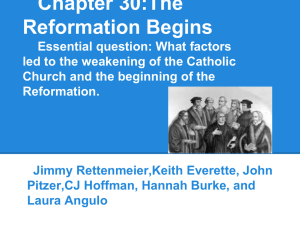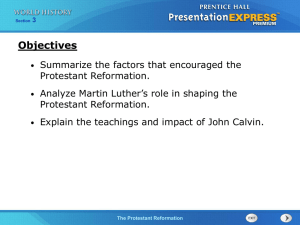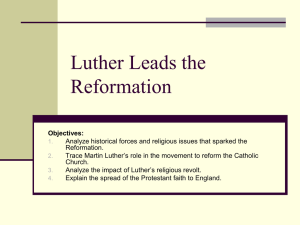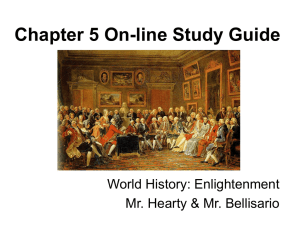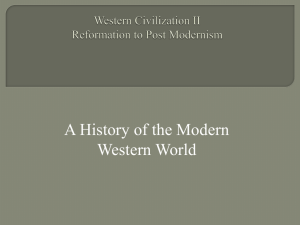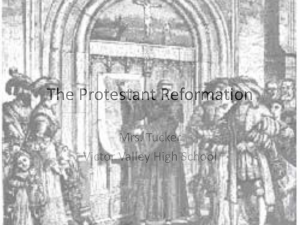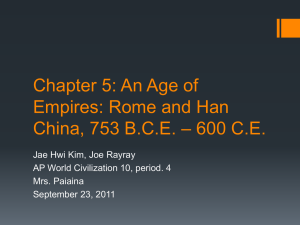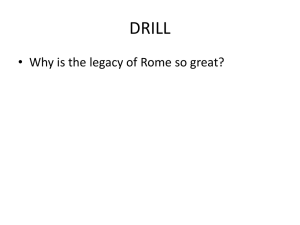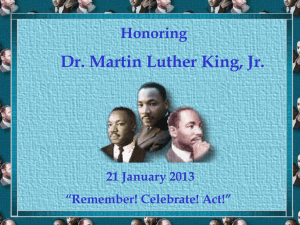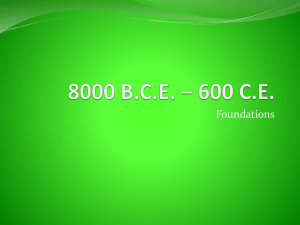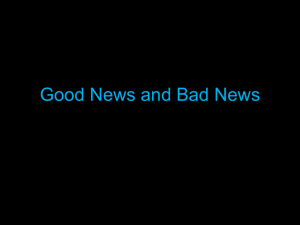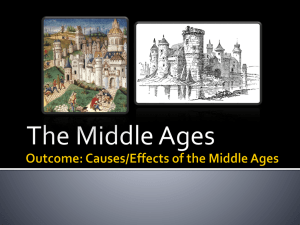Dr. Framji Minwala`s Lectures on Modernity
advertisement
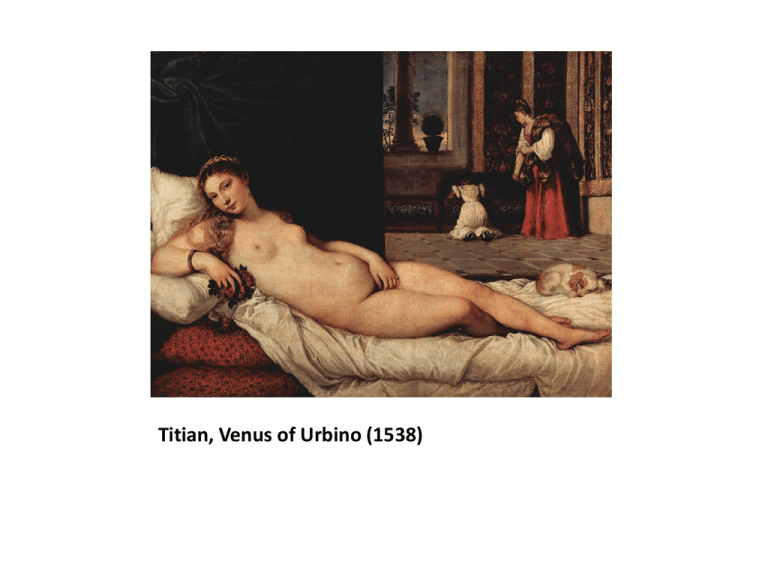
Titian, Venus of Urbino (1538) Manet, Olympia (1863-1865) Mario Sorrenti, Rive Gauche (After Olympia) (1988) Illuminated Bible, c. 1300 Framji’s Bookshelf, 2007 Giotto, The Crucifixion (c. 1304-5) Andres Serrano, Piss Christ (1988) Major Periods in European History • Greece: Archaic, Classical/Hellenic, Hellenistic (800BC200BC) • Roman: Republic, Empire, Christian Rome (500BC-500AD) • Medieval: Early, High, Late (500AD-1500AD) • Early Modern: Renaissance, Age of Exploration, Reformation, Enlightenment (1500AD-1800AD) • Modern: Industrial Revolution, Colonial/Imperial, Romantic, Victorian, Machine Age, WWI, Interwar (1800AD-1939AD) • World War II (1939AD-1945AD) • Postmodern: Cold War, Space Age, Information Age, Corporate Age, post-9/11 (1945AD-present) Periodization • The attempt to classify time • Periods often named after the fact, i.e. in hindsight with particular reference to the present • Decades/centuries grouped together according to ideological affinities and sustained social formations • A system of classification that is inherently artificial— serves as a convenient short-hand for historians who assess shifts in human thinking, perception, behavior, and interaction • Useful in that it allows historians to identify patterns of development, shifts in collective imagination, decisive events that altered social organization. Raymond Williams on Culture • a general process of intellectual, spiritual and aesthetic development • a particular way of life, whether of a people, a period, a group, or humanity in general [articulated through symbolic systems of signification] • the works and practices of intellectual and especially artistic activity [rendered materially, i.e. through artifacts, texts, technologies, consumer products] Raymond Williams on Values • Residual • Dominant • Emergent Cultural Processes 1. Culture is learned, not innate—knowledge, beliefs, values are transmitted from one generation to the next. We call this process socialization. 2. Cultures are not static, i.e. they change over time— shifts in social structures and relationships precipitate shifts in communal systems of belief. 3. Cultures are adaptive, i.e. patterns of social behavior change as modes of social (economic, political, technological, religious) organization change. 4. Cultures are integrative, i.e. they appropriate ideas and practices from neighboring (and today, far-flung) locations. Synchronic vs. Diachronic • Synchronic: limited to an analysis of subject at a particular moment in time (and often a particular location) with seemingly little concern for the historical forces or progression of events that shaped the current state of the subject studied. Structural analysis. • Diachronic: concerned with evolution/change over time; focused on causal/sequential understanding. Process analysis. “Mr. Bennett and Mrs. Brown” “On or about December 1910, human character changed. I am not saying that one went out, as one might into a garden, and there saw that a rose had flowered, or that a hen had laid an egg. The change was not sudden and definite like that. But a change there was, nevertheless; and, since one must be arbitrary, let us date it about the year 1910.” --Virginia Woolf, “Mr. Bennett and Mrs. Brown” 1924 Early Modern Phases Two distinct phases: • Reformation (1490s/1500s-1650s) • Enlightenment (1650s-1800) Reformation Reformation • • • • Primarily defined as a reaction against abuses committed by, and wealth amassed by the Church. Major figures: Martin Luther, John Calvin. Revival of Classical Humanism (Protagoras (pre-Socratic Greek philosopher): “Man is the measure of all things.”) Late Medieval/Early Modern humanists: Petrarch, Boccaccio, Cosimo de Medici, Pope Pius II, Agricola, Mirandola, Erasmus, Machiavelli, Bembo, Ariosto, Thomas More, Castiglione, Herberstein, Aretino, Rabelais, Bruno, Montaigne). More philologists (study of language in historic sources) than philosophers, instrumental in translating/recovering Greek/Roman texts from Arabic sources. Establishes a cult of antiquity. Proliferation of universities, first established in the late 13th century in major cities: Cambridge, Paris, Oxford, Heidelberg, Bologna, Naples, Krakow, Prague (universitas literally means guilds of persons). Expansion and diversification of university curriculum—Quadrivium (Arithmetic, Geometry, Music, Astronomy/Astrology) added to Trivium (Grammar, Logic, Rhetoric). Trivium reformed to include studies in History and Philosophy (distinct from theology). Graduate degrees in Law and Medicine established. Proliferation (after 1500) of primary and secondary education—all under secular control--teaching elementary literacy and mathematics. Gradual shift away from guilds and apprenticeships, and from monastic schools. Reformation Reformation • Reinvention of the movable, metal type and technological improvements to processes of printing. • Widespread consolidation and use (in oral and written communication) of vernacular languages (German, French, Italian, English). Leads to a flowering of literature (Italian Cinquecento, Elizabethan & Jacobean, French Neoclassical, Spanish Golden Age). Precipitated by celebrity literary figures of the late medieval period (Chaucer, Dante, Petrarch, Boccaccio, William Langland, Francois Villon • Publication of scientific treatises, increase in scientific experimentation, advances in mathematical thinking, advances in medicine building on classical and Arabic learning—Copernicus, Descartes, Bacon, Galileo. Application of scientific principles to artistic practice. Reformation • Counter Reformation: Catholic Church response to Martin Luther, John Calvin, and other Christian reformers. Establishment of the Jesuit Order—missionaries who preached Catholicism across the world. Plunges continental Europe into a century of religious wars. • Exploration/Imperialism: conquest and acquisition of global territories by major European powers (France, Spain, England, Portugal, Italy). Opening of trade routes to Asia, Americas, Africa to establish markets for European manufacturing. Exploitation of territorial resources to sate the appetites of an exponentially expanding European middle class (made possible by the 13th century invention of the nautical magnetic compass). • Demographic shifts toward urban centers, population growth, increasing importance of cities in defining political and social identity. Synoptic Timeline • • • • • • • • • • c.1346-1353 The Black Death kills between 100-200 million people across Europe, the Middle East, and Asia. Many of the economic, social, religious, and cultural upheavals of the following two centuries can be attributed to the pandemic. c.1450 Gutenberg re-invents moveable type (first invented in China around 1040AD) and the printing press (1450AD). Gutenberg Bible (in Latin) published 1454. c. 1453 Fall of Constantinople (end of Christian domination in the near east); end of the Hundred Years’ War—1337-1453 (France drives England from almost all continental territory—emergence of nationalist sentiment). 1460 First stock exchange established in Antwerp (Belgium). 1469 Lorenzo de’Medici takes control of Florence. Patron of the arts and philosophy. Full flowering of the Italian Renaissance. Da Vinci, Botticelli, Ghirlandaio, Michelangelo, all members of his court. Retrieval and translation of classical philosophy from Arabic. c. 1480-1500 Portuguese cartographers revolutionize map-making, develop accurate nautical charts using scientific principles. Printed maps facilitate travel both by sea and by land. (Grand Voyer— literally “overseer”--appointed in 1599 in France to assure quality control over road maps). 1492 Columbus to W. Indies—Age of Exploration begins; expulsion of the Moors from Iberia. 1493 Albrecht Durer, the first prolific self-portraitist, poses for himself dressed in high-Italian fashion. 1494 Spain and Portugal sign the Treaty of Tordesillas, dividing the New World between them. 1497 John Cabot leads the first English expedition to the New World. Vasco da Gama lands in Calicut, India. Synoptic Timeling • • • • • • • • • • • • 1500 Pedro Cabral lands in what is today Brazil and claims it in the name of King Manual I of Portugal. 1502 Portuguese establish permanent settlement in Goa (lasts until 1961). 1503-1515 Aldus Manutius invents the pocketbook, formalizes book design, invents punctuation, develops and designs the first formal fonts and typefaces. Advocates the study of Greek, and the recuperation and publication of classic Greek literature and philosophy. 1508-1512 Michelangelo paints the ceiling of the Sistine Chapel. 1509 Desiderius Erasmus writes The Praise of Folly, a satirical attack on Medieval superstitions dedicated to Sir Thomas More. 1513 Machiavelli’s The Prince circulates through Italy (officially published 1532); 1516 Publication of Thomas More’s Utopia; the birth of modern political thought. 1517 Martin Luther nails ninety-five theses to a church door in Wittenberg—Reformation begins. Da Vinci paints The Last Supper. 1519-1522 The Magellan-Elcano expedition first circumnavigates the globe, a feat later repeated by Sir Francis Drake from 1577-1580. 1523 Albrecth Durer completes Four Books on Human Poportion c. 1523-1571 Michelangelo designs and builds the Laurentian Library in Florence. Revolutionary use of space—the building was thought to mimick the tensions, energy, and vitality of the human body. 1525 Pietro Bembo publishes Prose della volgar lingua, a treatise on the effective use of Tuscan Italian as a literary medium. Establishes Petrarch 1304-1364 (“Father of Renaissance Humanism”) as the perfect model, formalizes the use of literary conventions. 1531-1534 Henry VIII breaks with the Catholic Church in Rome, appoints himself head of the newly formed Church of England. Synoptic Timeline • • • • • • • • 1532 Francisco Pizarro conquers the Incan Empire, establishes Spanish domination in Latin America. Ludovico Ariosto publishes Orlando Furioso, a celebration of humanist ideals through its satiric treatment of medieval codes of honor and chivalry. 1532-1564 Francois Rabelais publishes all five parts of Gargantua and Pantagruel, a scatological, satirical, grotesque novel lampooning social and political life. 1536 John Calvin, French theologian, publishes Institutes of the Christian Religion while in exile in Geneva, a major statement of reformist doctrine. Formulates an influential theory of predestination. Considered the founder of Reformed, Congregational, and Presbyterian churches. 1540 Pope Paul III approves the organization of the Society of Jesus (Jesuits) proposes by Ignatius of Loyola. Loyola and his followers founded Catholic educational institutions across Europe and then throughout the world, the highest concentration in the Americas, China in the 16th & 17th centuries, and in India. Jesuit institutions promote the study of science and astronomy, of western and eastern philosophies, and of Christian theology. 1543 Copernicus publishes On the Revolutions of Heavenly Bodies (Earth goes around the Sun). 1545-1563 Council of Trent: 25 sessions, met at the instigation of Charles V to establish ecumenical principles that affirmed Church doctrine in opposition to emerging Protestant thinking. CounterReformation begins. End of the medieval church. 1550 Giorgio Vasari publishes Lives of the Most Eminent, Painters, Sculptors, and Architects, with a dedication to Cosimo I de’Medici. The first encyclopedia of artist biographies. 1555 Peace of Augsburg, treaty between Catholic and Lutheran forces that affirmed a legal/political division in Christendom. Synoptic Timeline • • • • • • • • • • • • • 1555 John Lok, a London trader, transport the first African slaves to England from Guinea. England dominated the slave trade throughout the 16th and 17th centuries. 1558 Elizabeth I succeeds to the throne of England, consolidates the English Protestant Church. 1569 Gerardus Mercator, a Flemmish cartographer, develops a mathematical technique that produces the most accurate possible projection of the world to date. 1570 In Antwerp, Abraham Ortelius publishes the first modern atlas, Theatrum Orbis Terrarum. 1575 Torquato Tasso completes Jerusalem Liberated (published 1580), an epic romance about the first crusade, styled after Homer and Vergil. 1588 Defeat of the Spanish Armada and the emergence of England as an Imperial power. 1591-2 Shakespeare writes and stages Henry VI Parts 1-3. Christopher Marlowe’s The Jew of Malta performed. Ushers in the great age of Elizabethan/Jacobean drama in London. 1595 Johannes Kepler publishes The Cosmographic Mystery, first published defense of the Copernican system. 1596 Edmund Spenser publishes The Faerie Queene. 1598 Henry IV of France issues the Edict of Nantes, granting Calvinist Protestants (Huguenots) civil rights in order to promote civil unity (revoked by Louis XIV in 1685). 1599 Globe Theatre opens on the South Bank of the Thames, London. 1600 Giordano Bruno, Italian humanist, tried by the Inquisition and burned at the stake for holding opinions contrary to the Catholic faith. 1602 Founding of the Dutch East India Company. Synoptic Timeline • • • • • • • • • 1603 James 1 of England & Ireland/James VI of Scotland crowned king. Unification of the United Kingdom. British colonization of the Americas begins. 1605 Miguel de Cervantes publishes the first part of Don Quixote, considered a founding work of modern Western literature. 1618-1648 Thirty Years War concludes with the signing of a sequence of treaties collectively known as the Peace of Westphalia (1648). Between 3 million and 11 million people die, mostly in the states that make-up Germany today. 1620 Francis Bacon publishes his Novum Organum (New Method), the first systematic articulation of empirical, scientific reasoning and principles. 1623 Galileo Gallilei publishes The Assayer, a manifesto on scientific principles and an attack on pseudo-scientific scholarship. 1637 The Worshipful Company of Gunmakers established by charter in London to regulate the manufacture of handguns. 1637 Pierre Corneille, considered the “father of French tragedy” writes and produces Le Cid. 1642 English Civil War begins—concludes 1659/1660. 1648 Peace of Westphalia concludes the last of the so called religious wars that convulsed Europe after the Reformation. Introduced the notion of a sovereign state, established a prejudice against foreign intervention in domestic affairs, created a legal basis for national self-determination, demarcated national boundaries across Europe, and recognized each sovereign state’s determination of a national religion (Catholic, Lutheran, Calvinist). Established a core group of European states that dominated global politics until the 19th century: Austria, England, France, Spain, Russia, and the United Provinces of the Netherlands and Belgium. Emergence of Printing c. 7th Century: Block printing invented in China and Japan. c. 11th Century: Movable wooden type invented in China, but not used as primary method to produce texts. c. 1450: Johannes Gutenberg of Mainz (Germany) re-invents movable metal type and a more efficient printing press, so called because it pressed pages (parchment or vellum) against prearranged blocks of text (resembles, and possibly influenced by wine presses). Letters designed to imitate caligraphic forms used by medieval illuminators. 1450: Mass produces papal indulgences. 1454: First printed bible. 1455: Aelius Donatus’ Ars Minor (The Minor Art), the most widely used Latin grammar. Spread of Printing • By 1500, there were printing presses in more than250 European locations: Italy 80, Germany 52, France 43. • 23,000 editions in circulation (assuming a print run of at least 500, this means approx. 13 million books—Eur. population approx. 100 million). • First press in the Islamic world not until 1726 (Turkey), but short-lived. Not re-established until c. 1820s. First unofficial Turkish (Ottoman) newspaper published in 1840. Effects of Printing • Quick and widespread dissemination of classical and medieval thinking (revival of classical learning—Greek, Roman). • Increase in literacy. • Shift of knowledge from the clergy to the developing merchant class and the bourgeoisie. • Referred to as an “information explosion.” Requires new methods of storage and retrieval, so new methods of classification. • Scholars and thinkers have inexpensive access to the thinking and work of other scholars working in disparate locations—knowledge built on previous knowledge (especially important for both science and philosophy). • Ready availability of texts for study in universities. • Educational shift from monastic primary and secondary schools to state established educational institutions (texts now available for teaching). Effects of Printing • • • • • • • Consolidation of vernacular languages (French, German, Spanish, Italian, English, Russian—by 1550, poets/playwrights composing primarily in the vernacular and not Latin, which helps develop solid ground for communal, later national, identity distinct from both religious, i.e. Christian, and European structures of belonging. Self-consciousness awareness of philosophers, scientists, poets, essayists producing work that would last—Stephen Greenblatt describes this in his study Renaissance Self-fashioning. Emergence of municipal and social bureaucracies to manage increasing paperwork. Increased efficiency in the management of political communications, especially manifested in control over colonial territories. Dissemination of European texts across the globe, which helped facilitate a Eurocentric understanding of world. Began the process through which standardized forms of language and punctuation emerge. Made commercial advertising possible. Accelerated the pace of dissent and containment through the mass production and dissemination subversive/heretical texts and Catholic responses to these. Threatened the legitimacy of church doctrine. Luther & the Reformation First major schism in Christianity, initiated by reformers objecting to specific church doctrines, hierarchy, rituals, political structure. • 1517: Martin Luther posts 95 Theses on the door of Castle Church in Wittenberg, Germany. Martin Luther claimed that what distinguished him from previous reformers was that while they attacked corruption in the life of the church, he went to the theological root of the problem—the perversion of the church’s doctrine of redemption and grace. Luther, a pastor and professor at the University of Wittenberg, deplored the entanglement of God’s free gift of grace in a complex system of indulgences and good works. In his Ninety-five Theses, he attacked the indulgence system, insisting that the pope had no authority over purgatory and that the doctrine of the merits of the saints had no foundation in the gospel. Here lay the key to Luther’s concerns for the ethical and theological reform of the church: Scripture alone is authoritative (sola sciptura) and justification is by faith (sola fide), not by works. While he did not intend to break with the Catholic church, a confrontation with the papacy was not long in coming. In 1521 Luther was excommunicated; what began as an internal reform movement had become a fracture in western Christendom. Luther & the Reformation The recently-invented printing press helped Luther's writings (including the Ninety-five Theses and his German translation of the Bible) spread across the West in a matter of weeks. Thanks to the expanding middle class (which possessed the time and wealth to become literate and peruse scholarly works), they reached an unprecedented number of people. They were warmly received by the northern German states, which spurred conflict as the Holy Roman Empire attempted to suppress the Protestant movement. Lutheranism also spread (peacefully) across Scandinavia. Counter Reformation • The Roman Catholic Church responded to the Reformation with the Counter Reformation, spanning roughly the same period. This movement, which sought to reverse the losses of the Reformation, included campaigns of varying success to combat excess and corruption among the clergy, as well as renewed efforts to relieve poverty. The Society of Jesus (aka the Jesuits), founded during this period, would further the Catholic cause around the world. The Jesuits built many schools and performed extensive mission work, notably in East Asia and Latin America. • The dramatic Baroque style of visual art, with its potential to flood viewers with spiritual awe, was a key instrument of the Counter Reformation. Unfortunately, the movement also featured intensified use of inquisition, especially in Spain. Council of Trent Council of Trent, 16th ecumenical council of the Roman Catholic church (1545–63), important for its sweeping decrees on self-reform and for its dogmatic definitions that clarified virtually every doctrine contested by the Protestants. Despite internal strife, external dangers, and two lengthy interruptions, the council played a vital role in revitalizing the Roman Catholic church and its spiritual (as opposed to political) mission throughout Europe. • • • 1545-1547: Establishes agenda and identifies areas for reform while simultaneously clarifying church doctrine. 1551-2: Delegates complete decree on the Eucharist that defined the Real Presence of Christ in opposition to the interpretation of Zwingli, the Swiss Reformation leader, and the doctrine of transubstantiation as opposed to Luther. The sacrament of penance (the granting of indulgences) was extensively defined, extreme unction (anointing the sick) explained, and decrees issued on episcopal jurisdiction and clerical discipline. 1562-1563: Defined that Christ is entirely present in both the consecrated bread and the consecrated wine in the Eucharist. Defined the mass as a true sacrifice; issued doctrinal statements on holy orders, matrimony, purgatory, indulgences, and the veneration of saints, images, and relics; and enacted reform decrees on clerical morals and the establishment of seminaries. Reforms not enough for Protestants and reformers. A series of local religious wars engulf Europe, culminating in the 30 Years War (1618-1648) on the continent and the Wars of the Three Kingdoms (including the English and Scottish Civil Wars) (1639-1651). Religious differences were as much a cause as a pretext—the political domination of Europe by the Catholic Church was a central underlying issue. After the wars, the church lost much of it’s political authority Wars of Religion Reforms not enough for Protestants and reformers. A series of local religious wars engulf Europe, culminating in the 30 Years War (1618-1648) on the continent and the Wars of the Three Kingdoms (including the English and Scottish Civil Wars) (1639-1651). Religious differences were as much a cause as a pretext—the political domination of Europe by the Catholic Church was a central underlying issue. After the wars, the church lost much of it’s political authority, and it’s ability to control the nobility through threats of excommunication. At the conclusion of the 30-years war, historians estimate that Europe had lost between 25% to 40% of its population (at least partly to disease). The Holy Roman Empire lost much of its authority over Europe. European political relationships radically reorganized—Spain weakened, the fragmentation of Germany, depletion of the English treasury. France ascendant. Proxy wars fought throughout European colonial territories (repeated later during the Seven-Years War (1754-1763—fighting in Europe, the Americas, West Africa, India, the Philippines). Wars of Religion • • • • • German Peasants' War (1524–1525) Schmalkaldic War (1546–1547) in the Holy Roman Empire Eighty Years' War (1568–1648) in the Low Countries French Wars of Religion (1562–1598) Thirty Years War (1618–1648), affecting the Holy Roman Empire including Habsburg Austria and Bohemia, France, Denmark and Sweden • Wars of the Three Kingdoms (1639–1651), affecting England, Scotland and Ireland – Scottish Reformation and Civil Wars – English Reformation and Civil War – Irish Confederate Wars and the Cromwellian conquest of Ireland Europe at the end of the 30-Years War Peace of Westphalia • The treaties initiated a new system of political order in central Europe, later called Westpahlian Sovereignty, grounded in the concept of a sovereign state governed by a sovereign (monarch) and establishing a prejudice in international affairs against interference in another nation's domestic business. The treaty not only signaled the end of the destructive wars that had ravaged Europe, it also represented the triumph of sovereignty over empire, of national rule over the personal writ of the Austrian Habsburgs (controlled the papacy and the Holy Roman Empire). The treaties' regulations became integral to the constitutional law of the Holy Roman Empire, and stood as a precursor to the development of international law governing the behavior of nation-states. • Did not restore peace throughout Europe; France and Spain remained at war for eleven more years. But created a basis for national self-determination, and served as the precursor to what we understand today as the modern nation. Vernacular Languages • 1450-1590: First vernacular grammar books written, and later published: Italian, Spanish, French, Dutch, German, English. • Spread of vernacular languages through print and primary and secondary education begins to define distinct European identities in linguistic term. Languages both determine, and frame, social belonging. • By 1600, dictionaries in all these languages published. • Latin increasingly an academic language, studied in universities, used to publish scientific treatise. • Benedict Anderson suggests that the use and dissemination of vernacular languages through print culture helps define “imagined communities”, a socially constructed sense of affinity with people in disparate locations. (Imagined Communities, 1983). Precursor to the development of a “public sphere”. Enlightenment Enlightenment is man's release from his selfincurred tutelage. Tutelage s man's inability to make use of his understanding without direction from another. Self-incurred is this tutelage when its cause lies not in lack of reason but in lack of resolution and courage to use it without direction from another. Sapere aude! "Have courage to use your own reason!"- that is the motto of enlightenment. ---Immanuel Kant, “Answering the Question: What is Enlightenment” 1784 Enlightenment In French, Siecles des Lumieres In German, Aufklarung The “light” referred to is the light of reason. • Attempts to synthesize ideas concerning God, reason, nature, and man into a worldview, a founding and unifying ideology. • Instigated the production of new theoretical knowledge in fields as diverse as medicine, philosophy, politics, the arts, history, physics, history, astronomy, and mathematics. • Fundamental belief that reason, and knowledge derived from rational methods of investigation and analysis, would help free humans from both intellectual and social bondage, and create conditions within which happiness could be achieved. Enlightenment • • • • • • An understanding that knowledge could be codified, classified, analyzed, and understood. (Francis Bacon, Samuel Johnson, Denis Diderot) That nature was not simply a manifestation of God’s will or vision, but instead was (and is) governed by natural laws that could be derived through empirical observation and experiment. (Galileo, Bacon, Newton, Descartes) Freedom to pursue avenues of philosophical and scientific investigation wherever these may lead, i.e. no matter how antithetical to religious belief or doctrine. A developing understanding that the dissemination of ideas could have specific social effects and consequences, and so the harnessing of these to effect social and political change. (political revolutions) An acute awareness of the self as part of history, a historical sensibility separate from a Biblical construction of time, i.e. Genesis to Revelations. (Gibbon) Self-conscious investigation of the human being as both a biological entity and a social subject. Enlightenment • Political philosophers question the divine right of monarchs to rule. Propose forms and modes of democratic and republican governance that extend Greek and Roman classical thought. (Hobbes, Rousseau, Locke, Hume) • Analytical philosophers investigate the nature of thought (epistemology) and of being (ontology), and propose ways to think about human consciousness distinct from theological and doctrinal articulations. (Descartes, Spinoza, Leibniz, Voltaire) • Emergence of coffee houses in England & Germany, salons in France. The development of the “bourgeois public sphere”. Note on the Public Sphere “By "the public sphere" we mean first of all a realm of our social life in which something approaching public opinion can be formed. Access is guaranteed to all citizens. A portion of the public sphere comes into being in every conversation in which private individuals assemble to form a public body.' They then behave neither like business or professional people transacting private affairs, nor like members of a constitutional order subject to the legal constraints of a state bureaucracy. Citizens behave as a public body when they confer in an unrestricted fashion-that is, with the guarantee of freedom of assembly and association and the freedom to express and publish their opinions-about matters of general interest. In a large public body this kind of communication requires specific means for transmitting information and influencing those who receive it. Today newspapers and magazines, radio and television are the media of the public sphere. We speak of the political public sphere in contrast, for instance, to the literary one, when public discussion deals with objects connected to the activity of the state. Although state authority is so to speak the executor of the political public sphere, it is not a part of it.2 To be sure, state authority is usually considered "public" authority, but it derives its task of caring for the wellbeing of all citizens primarily from this aspect of the public sphere.” --Jurgen Habermas, “The Public Sphere: An Encyclopedia Article” (1964) Note on the Public Sphere “The bourgeois public sphere could be understood as the sphere of private individuals assembled into a public body, which almost immediately laid claim to the officially regulated "intellectual newspapers" for use against the public authority itself. In those newspapers, and in moralistic and critical journals, they debated that public authority on the general rules of social intercourse.” ---Jurgen Habermas, “The Public Sphere: An Encyclopedia Article” (1964) Opium v. Chocolate • By 1650, widespread recreational use of opium (from China) and tobacco (from North America), and coffee and chocolate (from South America). • Café culture and salons emerge in England and France—the substance imbibed determined the intellectual tenor of the café/salon. • If coffee and chocolate helped spur thinkers (they were wired all the time), opium influenced literary figures and artists (high all the time). Empiricism vs. Rationalism Francis Bacon, the father of the scientific method and empirical enquiry. “I propose to establish progressive stages of certainty. The evidence of the sense, helped and guarded by a certain process of correction, I retain. But the mental operation which follows the act of sense I for the most part reject; and instead of it I open and lay out a new and certain path for the mind to proceed in, starting directly from the simple sensuous perception. . . “ –Novum Organon (New Method) Empiricism vs. Rationalism Rene Descartes, father of rationalism. “It is true that so long as I merely considered the ways of life of other men I found little basis for confidence, observing in them almost as much variation as I had found previously in the opinions of philosophers. The greatest benefit I extracted from these observations was their showing me many things which, although seeming wild and ridiculous to us, are nevertheless commonly accepted and approved in other great nations; which taught me not to believe too firmly anything I had been convinced of only by example and custom. This would gradually free me from many errors that may obscure our natural light and make us less capable of heeding reason. But after I had spent some years pursuing these studies in the book of the world, and trying to gain some experience, I made a decision one day to undertake studies within myself too and to use all the powers of my mind in choosing the paths I should follow.” --Discourse on Method Dualism v. Monism Cartesian Dualism: Descartes emphasizes the rigorous and methodical use of reason to arrive at solutions to scientific questions. Dualism: The body functions like a machine, takes material form, but has no thinking ability (an issue investigated by Pavlov in late 19th century), and I therefore governed by the laws of nature—can decay. The mind (or soul), however, is immaterial and does not follow these natural laws. Proposes that the human ability to think and act rationally suggests that the mind controls the body. But that the instinctive, emotional responses of the body can also, at times, influence the mind. Spinoza and Monism: The mind and body are organically unified and composed of the same substance. The distinctions one makes between the two are fundamentally arbitrary. The mind-body split established an agenda for both philosophical and scientific investigation for the next 350 years. The Encyclopedia Denis Diderot & Jean le Rond d’Lambert published Encyclopedie, ou dictionnaire des sciences et des metiers, 35 volumes, 75,000 entries, from 1759-1772. Contributions from many major thinkers, including Rousseau, Voltaire, Montesquieu. “The goal of an Encyclopédie is to assemble all the knowledge scattered on the surface of the earth, to demonstrate the general system to the people with whom we live, & to transmit it to the people who will come after us, so that the works of centuries past is not useless to the centuries which follow, that our descendants, by becoming more learned, may become more virtuous & happier, & that we do not die without having merited being part of the human race.” --Diderot Enlightenment Philosophers • • • • • • • • • • Selected Major Figures Rene Descartes, French (1596-1650) Baruch Spinoza, Dutch (1632-1677) John Locke, English (1632-1704) Gottfried Leibniz, German (1646-1716) Pierre Bayle, French (1647-1706) George Berkeley, Irish (1685-1753) Voltaire, French (1694-1778) David Hume, English (1711-1776) Jean-Jacques Rousseau, French (1712-1778) Immanuel Kant, German (1724-1804) Enlightenment Scientists Selected Major Figures Francis Bacon, English (1561-1626) Galileo Galilei, Italian (1562-1642) Christian Huygens, Dutch (1629-1695) Isaac Newton, English (1642-1727) Edmond Halley, English (1656-1742) Gabriel Farenheit, Polish/Dutch (1686-1736) Francois Quesnay, French (1694-1774) Benjamin Franklin, American (1706-1790) William Herschel, German/English (1738-1822) Alessandro Volta, Italian (1745-1827) Caroline Herschel, German/English (1750-1848) Friedrich Mohs, German (1773-1839) Enlightenment Timeline • • • • • • • • • 1620—Francis Bacon publishes his Novum Organum (New Method). 1632—First coffee shop opens in London. 1633—Galileo condemned by the Inquisition, forced to recant his teachings; Rene Descartes (1596-1650) abandons Treatise on the World (though publishes parts of this four years later) to avoid charges of heresy. 1636—Pierre de Fermat (1601-1665) circulates pioneering manuscript on analytical geometry—Ad Locos Planos et Solidos Isagoge (Introduction to Plane and Solid Loci—posthumously published 1679). 1637—Descartes publishes Discourse on the Method on Rightly Conducting One’s Reason and of Seeking Truth in the Sciences (groundwork for analytical/rational philosophy). Contains the famous quote, “Je pense, donc je suis.” Includes sections from the Treatise, including Geometry, literally inventing the field of modern geometry and modern algebraic notation. 1637—Fermat’s Last Theorem (Fermat’s Conjecture) scribbled as a marginal note in Diophantus’ Arithmetica. Not proven until 1994. Attempts at proving the theorem significantly advance algebraic number theory. 1641—Descartes publishes Meditations on First Philosophy. 1642-1651—England's Puritan Revolution and Civil Wars. Oliver Cromwell (1599-1658) overthrows the monarchy, establishes Parliamentary rule in England, and conducts a genocidal campaign against Catholics in England, Scotland, and Ireland. 1649—King Charles I (1600-1649) of England is publicly beheaded in London; outbreak of the Fronde (revolt of the parliament and the nobility against royal encroachment on their rights)—rebellion squashed in 1653. 1650—Descartes dies. Enlightenment Timeline • • • • • • • • • • • • • • • • • 1651—Thomas Hobbes publishes Leviathan, the first general theory of politics in the English language. 1653—Blaise Pascal publishes his “Treatise on the Arithmetical Triangle”. 1654—Pascal and Fermat correspondence lay the groundbreaking theoretical foundation for a science of probabilities. 1657—Chocolate drinking introduced in London. 1658—First bank not introduced in Sweden. 1660—English monarchy is restored—Charles II (1630-1685) returns from exile. 1661—Louis XIV (1638-1615) ascends the French throne; he’s 14 years old. Official reign began in 1643—ruled for 72 years (longest serving monarch in Europe). 1663—Charles II grants eight nobles, the Lords Proprietors, the Province of Carolina (British solidify colonial rule in North America); Pope Alexander VII (1599-1667) places Descartes works on the Index of Prohibited Works. 1666—Newton discovers gravity. 1667—John Milton publishes Paradise Lost. 1668—First apothecary shop established in Darmstadt, Germany. 1669—Blaise Pascal’s Pensees published posthumously. 1670—Secret treaty between Charles II and Louis XIV (Treaty of Dover)—led directly to the Third Anglo Dutch War and the deposition of Charles II. 1673—England's Test Act excludes Roman Catholics from holding office—“An act for preventing dangers which may happen from popish recusants.” 1677—Ice-cream is the rage in Paris. 1682—Louis XIV moves government and court to Versailles. 1686—Newton derives three laws of motion. Published findings the following year in Mathematical Principals of Natural Philosophy. Enlightenment Timeline • • • • • • • • • • • • • • • • 1688—England's Glorious Revolution—William III (Dutch-1650-1702) & Mary II (1662-1694) ascend to the throne. 1689-90—John Locke (1632-1704) publishes Two Treatises of Government—an argument against divinely sanctioned patriarchal monarchies and for civil government grounded in Hobbesian social contract theory. 1689—England's Bill of Rights—reflects Locke’s thinking. Central document limiting royal authority, codifying a set of principles for Parliamentary governance, and defines laws governing succession to the English throne. 1694—Bank of England founded. 1695—Royal Bank of Scotland founded. 1700—The dodo is extinct. 1707—Union between Scotland and England under the name of "Great Britain”. 1712—First record of vaccinations for small pox in France. 1714—Leibniz composes Mondaologie—precursor to scientific theories about the composition and movement of atomic and subatomic particles. 1717—Lady Mary Wortley Montagu, popularizes smallpox inoculation, a practice she had observed in Turkey. 1719—Daniel Defoe publishes Robinson Crusoe. First time a literary work is called a novel. 1728-1738—Spread of Freemasonry across Europe. 1737—David Hume publishes Treatise on Human Nature 1750—Jean Jacques Rousseau’s essay A Discourse on the Moral Effects of the Arts and Sciences is awarded by the Academy of Dijon 1751-72—Publication of The Encyclopédie in France (edited by Diderot, with contributions by d’Alembert, Holbach, Helvetius, Turgot, Haller, Morellet, Quesney, Voltaire, and Montesquieu) 1752--September 14, Great Britain adopts the Gregorian calendar. Enlightenment Timeline • • • • • • • • • • • • • • • • • • 1753—Founding of the Vienna stock exchange. 1755—Rousseau’s Discourse on the Origin of Inequality. Rousseau also publishes his Discourse on Political Economy in Diderot’s Enciclopédie. 1756-1763—The Seven Year's War. Global war fought by major European powers both on the continent and in colonial territories. 1757—Edmund Burke publishes A Philosophical Inquiry into the Origin of Our Ideas of the Sublime and Beautiful. 1762—Rousseau publishes The Social Contract. 1770--Dauphin of France marries Marie Antoinette. 1752--September 14, Great Britain adopts the Gregorian calendar. 1753—Founding of the Vienna stock exchange. 1755—Rousseau’s Discourse on the Origin of Inequality. Rousseau also publishes his Discourse on Political Economy in Diderot’s Enciclopédie 1756-1763—The Seven Year's War. Global war fought by major European powers both on the continent and in colonial territories. 1762—Rousseau publishes The Social Contract. 1766—Henry Cavendish identifies the hydrogen molecule. 1770--Dauphin of France marries Marie Antoinette; Rousseau publishes Emile. 1771—Encyclopedia Britannica assembled in London. 1776—Adam Smith publishes The Wealth of Nations. American colonies declare independence from England. 1777—American Revolution. 1778—Alliance between United States and France. 1780—Adam Weishaupt’s Order of the Illuminati swells to 300 hundred members. Forges alliances with masonic lodges throughout Europe. Enlightenment Timeline • • • • • • • • • • • • • 1783—Peace of Versailles between France, England, Spain, and United States. 1785—James Watt introduces the steam engine in England. Revolutionizes transportation. 1787—Signing of the Constitution of the United States. 1789—Outbreak of hostilities in France with the fall of the Bastille July 14. 1789—Abolition of French feudal system, Declaration of Rights of Man, nationalization of church property begins. 1790–Edmund Burke publishes his Reflections on the Revolution in France. 1791--French National Assembly dissolved. 1792--French Revolutionary Wars begin. 1793--Louis XVI and Marie Antoinette executed; Catholicism banned in France. 1793--First Coalition against France of Britain, Austria, Prussia, Holland, Spain; France declares war on Britain and Holland. 1795--France makes peace with Prussia, Tuscany, Spain; Bread riots in Paris. Napolean becomes commander-in-chief of the Fench army. 1798--France annexes left bank of the Rhine. 1799--Second coalition against France as Austria declares war. French Directory overthrown, Bonaparte coup d'etat and made First Consul. We shall not cease from exploration And the end of all our exploring Will be to arrive where we started And know the place for the first time. ---T. S. Eliot, “Little Gidding” Thick Description Thick description is a term used by cultural anthropologist Clifford Geertz to describe a method of cultural and social interpretation that assess patterns of human behavior through the historically and geographically specific contexts in which they occur. “What the ethnographer is in fact faced with —except when (as, of course, he must do) he is pursuing the more automatized routines of data collection— is a multiplicity of complex conceptual structures, many of them superimposed upon or knotted into one another, which are at once strange, irregular, and inexplicit, and which he must contrive somehow first to grasp and then to render. And this is true at the most downto-earth, jungle field work levels of his activity: interviewing informants, observing rituals, eliciting kin terms, tracing property lines, censusing households ... writing his journal. Doing ethnography is like trying to read (in the sense of “construct a reading of”) a manuscript — foreign, faded, full of ellipses, incoherencies, suspicious emendations, and tendentious commentaries, but written not in conventionalized graphs of sound but in transient examples of shaped behavior.”
